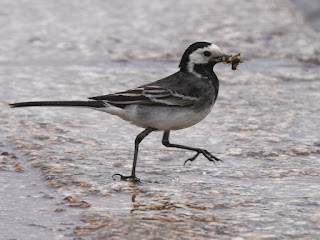A young Great Spotted Woodpecker beside the Long Water fluttered its wings and looked up appealingly ...
... at its father higher in the tree.
A pair of Magpies perched together in the next tree.
There was a family of Blue Tits checking another tree for insects. This is one of the young ones.
A Pied Wagtail collected insects for its nestlings on the edge of the Round Pond ...
... and flew off, going quite a distance to the southeast and disapopearing near the Queen's Temple. It might have a nest in the old stonework, though they also nest in tree holes and other crevices.
Several Black-Headed Gulls have already returned to the pond from their breeding grounds.
The Mandarin family were resting on the edge when a feral child rushed at them. They gradually recovered from the shock and settled down again.
The Mallard family continued their endless circling.
For several days a flock of Canada Geese has been building up on the Long Water. I was just on the other of the bridge when I saw them coming through in a great hurry. It was the dominant male Mute Swan who owns the Long Water, and had tired of their presence and decided to get rid of them.
One of them consoled itself by eating a fallen plum from a tree at the Triangle.
Another was eating a piece of apple someone had given it ...
... but carelessly dropped it into the water, and it was snatched by a young Herring Gull.
The bindweed so hated by the park management is very popular with insects. Honeybees climbed out of the flowers ...
... and a Batman Hoverfly rested on a leaf.
The supposed Batman logo on the thorax of this one, just behind the head, is very indistinct. But the pattern is a reminder that in pre-Batman times it was known as the Death's Head Hoverfly, and if you really stretch your imagination you can see that the narkinjg on the whole thorax has a faint resemblance to a black skull.
Ahmet Amerikali was at Rainham Marshes, where he got pictures of a Sedge Warbler ...
... a Reed Bunting ...
... and a Linnet.
Lastly, a pleasing shot sent from Málaga by Emilio Pacios: two young House Martins looking out from their nest.
We can't see the House Martin nests near the park, on the Kuwaiti embassy, because they're hidden in recesses in the ornate Victoria stucco cornice. It was sad to hear that the Regent's Park colony, on Rossmore House at the southwest corner of the park, had been wiped out by builders. It was much larger than the one on the embassy and the nests were in full view from the street.












%202025%201a.jpg)
%202025%201a.jpg)
%202025%201a.jpg)
%202025%201a.jpg)
They chirped at us while we were passing. The adults were making passes, clearly in some alarm. But I think they soon realized we posed no harm. Thankfully in many small villages hirundine nests are still an object of almost veneration.
ReplyDeleteGee, Canadas in the park don't live up to their fearsome reputation in the US and Canada.
Tinúviel
I've read that in many cultures, noyt just in Europe, having a hirundine nest on your house is a sign of good fortune. The nests on Rossmore House were much admired. Heaven know what oaf decided to wreck them.
DeleteYes, it is odd how docile the park Canadas are. Visiting Americans can hardly believe their eyes.